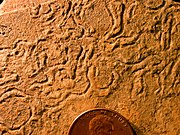Helminthopsis
Appearance
|
Nulla Vicipaediae Latinae pagina huc annectitur. Quaesumus in alias commentationes addas nexus ad hanc paginam relatos. Quo facto hanc formulam delere licet.
|


Helminthopsis est ichnogenus cuiusdam ichnofossilis quod in planitiebus saxorum sedimentariorum reperitur. Eius proprietates maximi momenti sunt vestigia brevia, curvilinearia, non ramificata, lateribus parallelis, sine lineis in superficiebus saxosis. Repraesentare putatur submarina vescendi vestigia ab organismo invertebrato facta qui victus petens superficies substratorum lutulentorum colebat.[1][2] A Gordia (flexuosa, lateribus parallelis, sine lineis) distinguitur quia se numquam transgreditur.[3]
Notae
[recensere | fontem recensere]Bibliographia
[recensere | fontem recensere]- Buatois, L. A., M. G. Mángano, C. G. Maples, et W. P. Lanier. 1998. Ichnology of an Upper Carboniferous fluvio-estuarine paleovalley: The Tonganoxie sandstone, Buildes Quarry, eastern Kansas, USA. Journal of Paleontology 72:152–180.
- Carmona, N. B., L. A. Buatois, M. A. Mángano, et R. G. Bromley. 2008. Ichnology of the Lower Miocene Chenque Formation, Patagonia, Argentina: animal - substrate interactions and the Modern Evolutionary Fauna. Ameghinian 45(1).
- Fillion, D., et R. K. Pickerall. 1990. Ichnology of the Upper Cambrian? to Lower Ordovician Bell Island and Waban groups of eastern Newfoundland, Canada. Palaeontographica Canadian 7: 1–41.
- Wang, Y., J. P. Lin, Y. L. Zhao, et P. J. Orr. 2009. Palaeoecology of the trace fossil Gordia and its interaction with nonmineralizing taxa from the early Middle Cambrian Kaili Biota, Guizhou Province, South China. Palaeogeography Palaeoclimatology Palaeoecology 277: 141–148. doi:10.1016/j.palaeo.2009.02.017.

